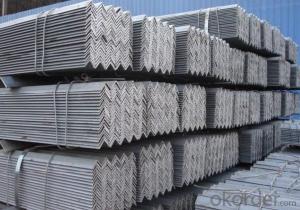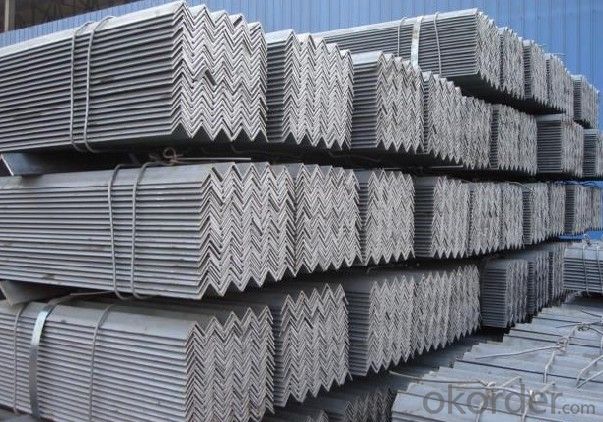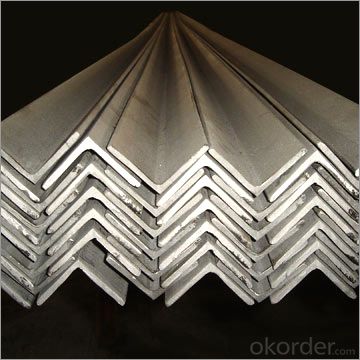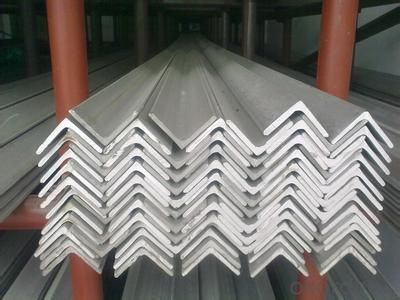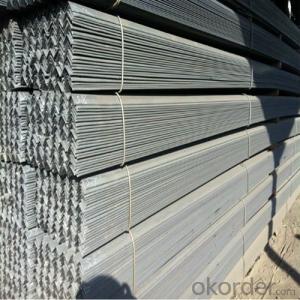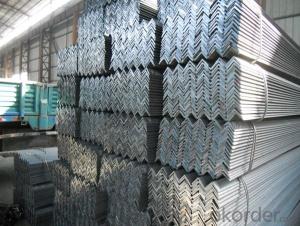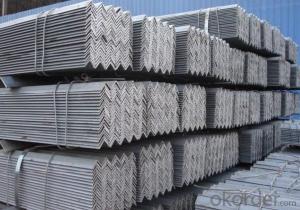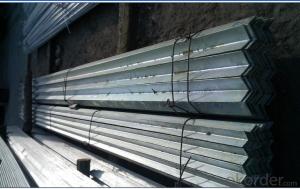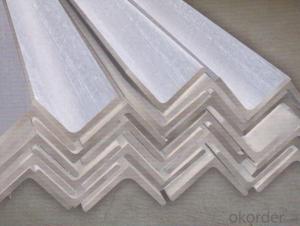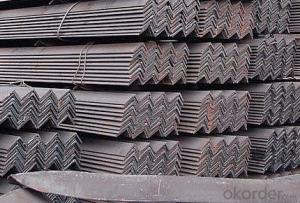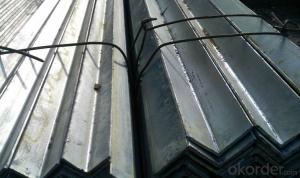Angle steel high quality
- Loading Port:
- China Main Port
- Payment Terms:
- TT OR LC
- Min Order Qty:
- -
- Supply Capability:
- -
OKorder Service Pledge
OKorder Financial Service
You Might Also Like
Product Description:
Stainless Steel Angles
1.Grade: SS200,300,400 series
2.Size: 25×25×3 mm-100×100×10mm
3.Process: HRAP
4. Length: 2-6m
5. Shape: Equal
6. Delivery: within 20 days
7. MOQ: 1 ton
8. Certificate: ISO 9001:2008, SGS
9. Package:Standard Export Packing, or put into wooden boxes according to your
requirement
10. Application: Construction, Marine, Industry and so on
Name | Stainless Steel Angles | ||||||
Standard | ASTM A554, A312, A249, A269 and A270 | ||||||
Material Grade | 304,316,201,202, 316L,430 | ||||||
Length | 6m or as customers' request | ||||||
Tolerance | a) thickness: +/-0. 15mm | ||||||
| |||||||
b) Length:+/-4. 5mm - 0mm | |||||||
Surface | 180G, 320G, 400G Satin / Hairline(Matt Finish, Brush, Dull Finish) 400G, 500G, 600G or 800G Mirror finish | ||||||
Application | Decoration construction, upholstery, industry instruments | ||||||
Test | Squash test, Extended test, Water pressure test, Crystal rot test, Heat treatment, NDT | ||||||
Chemical Composition of Material |
Composition
Material | 201 | 202 | 304 | 316L | 430 | |
C | ≤0.15 | ≤0.15 | ≤0.08 | ≤0.08 | ≤0.12 | ||
Si | ≤1.00 | ≤1.00 | ≤1.00 | ≤1.00 | ≤1.00 | ||
Mn | 5.5-7.5 | 7.5-10 | ≤2.00 | ≤2.00 | ≤1.00 | ||
P | ≤0.06 | ≤0.06 | ≤0.045 | ≤0.045 | ≤0.040 | ||
S | ≤0.03 | ≤0.03 | ≤0.030 | ≤0.030 | ≤0.030 | ||
Cr | 16-18 | 17-19 | 18-20 | 16-18 | 16-18 | ||
Ni | 3.5-5.5 | 4-6 | 8-10.5 | 10-14 |
| ||
Mo |
|
|
| 2.0-3.0 |
| ||
Mechanical Property | Material Item | 201 | 202 | 304 | 316L | ||
Tensile Strength | ≥535 | ≥520 | ≥520 | ≥520 | |||
Yield Strength | ≥245 | ≥205 | ≥205 | ≥205 | |||
Extension | ≥30% | ≥30% | ≥35% | ≥35% | |||
Hardness (HV) | <253 | <253 | <200 | <200 | |||
- Q: What are the different methods of surface galvanizing for steel angles?
- Steel angles can be surface galvanized using various methods, each with its own benefits and uses. Here are some commonly employed techniques: 1. Hot-dip galvanizing: The most widely utilized method involves immersing steel angles in molten zinc, forming a strong bond with the surface. This process offers exceptional corrosion protection and durability, making it suitable for a wide range of applications. 2. Electro-galvanizing: This method involves electrodepositing a thin layer of zinc onto the steel angle's surface. It is a controlled process that provides a smoother and more even coating. Electro-galvanizing is often used for decorative purposes or when a thinner coating is sufficient. 3. Sherardizing: This method entails coating the steel angles with a mixture of zinc dust and proprietary filler materials, such as aluminum or iron powder. The coated angles are then heated in a furnace, causing zinc to diffuse into the steel's surface, forming a durable alloy layer. Sherardizing is ideal for applications requiring high resistance to wear and abrasion. 4. Mechanical galvanizing: Also known as centrifuge galvanizing, this method involves tumbling steel angles in a drum or barrel with zinc powder and glass beads. The tumbling action helps zinc powder adhere to the surface, creating a protective coating. Mechanical galvanizing is commonly used for small or intricate parts that are challenging to galvanize with other methods. 5. Zinc-rich paint: Although not a conventional galvanizing method, zinc-rich paint can offer similar corrosion protection. It involves applying a paint or coating with a high concentration of zinc particles to the steel angle's surface. These zinc particles act as sacrificial anodes, corroding instead of the steel and safeguarding against rust and corrosion. These methods represent just a few options for surface galvanizing steel angles. The choice of technique depends on factors such as desired corrosion protection, specific application requirements, and cost considerations. Consulting with a galvanizing professional is crucial to determine the most suitable method for your needs.
- Q: Can steel angles be used for handrails?
- Yes, steel angles can be used for handrails. Steel angles are often used as a structural component for handrails due to their strength and durability. They can provide a sturdy and stable support for handrails in various applications.
- Q: Can steel angles be used in the construction of bridges?
- Yes, steel angles can be commonly used in the construction of bridges. Steel angles are versatile structural components that can provide additional strength and support to bridge structures. They are often used in the construction of bridge decks, railings, and supports. Steel angles are known for their high strength-to-weight ratio, which makes them ideal for bridge construction. They can withstand heavy loads and provide stability to the bridge structure. Additionally, steel angles are durable and resistant to corrosion, which is essential for bridges that are exposed to various environmental conditions. In bridge construction, steel angles are often used in conjunction with other steel components, such as beams and columns, to create a strong and reliable structure. They are commonly used as bracing elements to reinforce the overall stability of the bridge. Steel angles can also be used as connection elements, allowing different parts of the bridge to be securely joined together. Overall, steel angles are a crucial component in bridge construction, providing strength, durability, and stability to the structure. Their versatility and reliability make them a preferred choice for engineers and designers when constructing bridges of various sizes and types.
- Q: Are steel angles resistant to corrosion?
- Yes, steel angles are resistant to corrosion due to the protective oxide layer that forms on their surface, which helps prevent rusting and deterioration over time.
- Q: What are the different types of connections used for steel angles in structural applications?
- Steel angles in structural applications can be connected using various types of connections. These connections play a crucial role in maintaining the stability and strength of the overall structure. Firstly, welded connections are commonly used. This method involves fusing the edges of the steel angles together through melting, resulting in a strong bond. Welded connections are ideal for applications that require high strength and rigidity. Secondly, bolted connections provide flexibility as they involve using bolts and nuts to secure the steel angles. This type of connection allows for easy disassembly and reassembly if needed. Bolted connections are often chosen for their ease of installation and maintenance. Thirdly, riveted connections are a traditional method of joining steel angles. This involves inserting a rivet through holes in the steel angles and flaring the ends to secure them. Although riveted connections are known for their durability and resistance to corrosion, they are less commonly used today due to the time-consuming installation process. Next, clip connections utilize metal clips or brackets to attach the steel angles quickly and efficiently. These clips can be welded or bolted to the angles, making them suitable for applications where speed and ease of installation are important. Lastly, gusset plate connections involve using steel plates to connect the steel angles at their intersection points. These plates are typically welded or bolted to the angles, enhancing the strength and stability of the connection. Gusset plate connections are often employed when larger forces and moments need to be transferred. It is essential to consider the specific needs of the structure, including the structural requirements, loadings, and the intended application, when choosing the appropriate connection method. Adhering to design and engineering specifications ensures that the selected connection method is suitable for the desired use in structural applications.
- Q: Can steel angles be used in electrical grounding applications?
- Yes, steel angles can be used in electrical grounding applications. Steel angles are commonly used in construction for their strength and durability. In electrical grounding applications, steel angles can be used to create grounding grids or grounding systems. These grids or systems help to prevent electrical shock hazards by providing a low-resistance path for electrical currents to flow to the ground. Steel angles are often used as structural components in these grounding systems due to their ability to withstand physical stress and their conductive properties. However, it is important to ensure that the steel angles are properly installed and connected to the electrical system in accordance with relevant codes and standards to ensure effective grounding and safety.
- Q: Are steel angles suitable for manufacturing equipment enclosures?
- Indeed, steel angles prove to be an appropriate choice for the fabrication of equipment enclosures. Given their robustness and enduring nature, steel angles are widely utilized in both construction and manufacturing sectors. They furnish a solid framework for enclosing equipment and can be effortlessly joined through welding or bolting to ensure a secure enclosure. Moreover, steel angles can be tailored to suit precise dimensions and can be effortlessly adjusted or extended if necessary. In summary, steel angles present a dependable and economically viable solution for the production of equipment enclosures.
- Q: How do steel angles perform in terms of durability and longevity?
- Steel angles are known for their excellent durability and longevity. Due to their robust composition and resistance to corrosion, steel angles can withstand harsh environmental conditions, heavy loads, and extreme temperatures, making them highly durable. Moreover, their longevity is further enhanced by their ability to retain their structural integrity over prolonged periods without deteriorating. Overall, steel angles are a reliable and long-lasting choice for various construction and industrial applications.
- Q: What are the different types of steel angles used in architectural façade systems?
- There are several different types of steel angles used in architectural façade systems, including equal leg angles, unequal leg angles, L-shaped angles, and custom fabricated angles. These angles are used to provide structural support, create visual interest, and enhance the overall design of the building's exterior.
- Q: How do steel angles compare to other structural materials like wood or aluminum?
- Steel angles have several advantages over other structural materials like wood or aluminum. Firstly, steel angles are much stronger and more durable than wood or aluminum. They have a high strength-to-weight ratio, meaning they can support heavy loads while being relatively lightweight themselves. This makes steel angles ideal for applications requiring structural support or load-bearing capabilities. Secondly, steel angles are extremely resistant to environmental factors such as corrosion and fire. Unlike wood, which is susceptible to rot and decay, and aluminum, which can corrode when exposed to moisture or chemicals, steel angles can withstand harsh conditions and maintain their structural integrity over time. This makes them suitable for outdoor and industrial applications. Additionally, steel angles offer greater versatility and flexibility in design and construction. They can be easily shaped, welded, and manipulated to meet specific project requirements. This allows for greater creativity and customization in architectural and engineering projects. Moreover, steel angles have a longer lifespan compared to wood or aluminum. They require minimal maintenance and have a lower likelihood of needing repair or replacement, reducing long-term costs. This durability, combined with their superior strength, makes steel angles a cost-effective choice in the long run. However, it's worth noting that steel angles may be more expensive upfront compared to wood or aluminum. They also require specialized equipment and expertise for installation. Additionally, steel is a conductor of heat and electricity, so proper insulation or grounding may be necessary in certain applications. In summary, steel angles offer superior strength, durability, resistance to environmental factors, and design flexibility compared to wood or aluminum. While they may have a higher initial cost and require specialized installation, their long lifespan and cost-effectiveness make them a preferred choice for many structural applications.
Send your message to us
Angle steel high quality
- Loading Port:
- China Main Port
- Payment Terms:
- TT OR LC
- Min Order Qty:
- -
- Supply Capability:
- -
OKorder Service Pledge
OKorder Financial Service
Similar products
Hot products
Hot Searches
Related keywords
